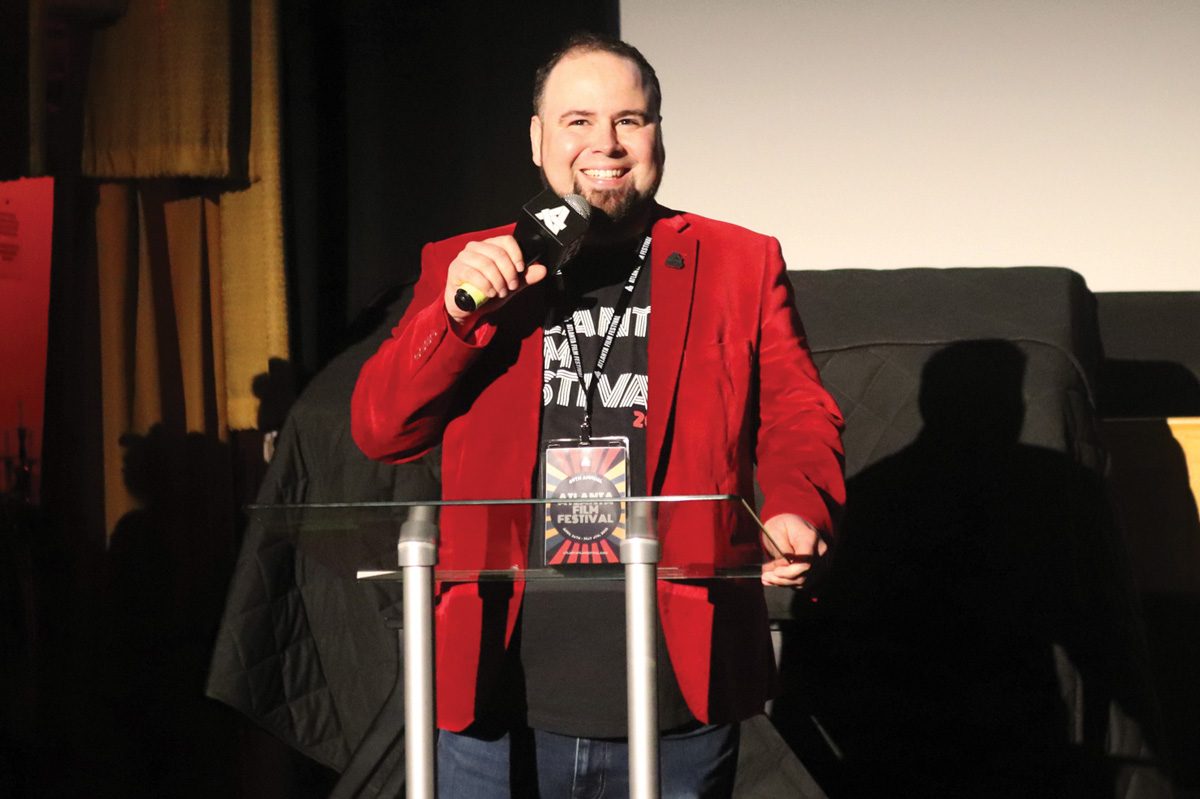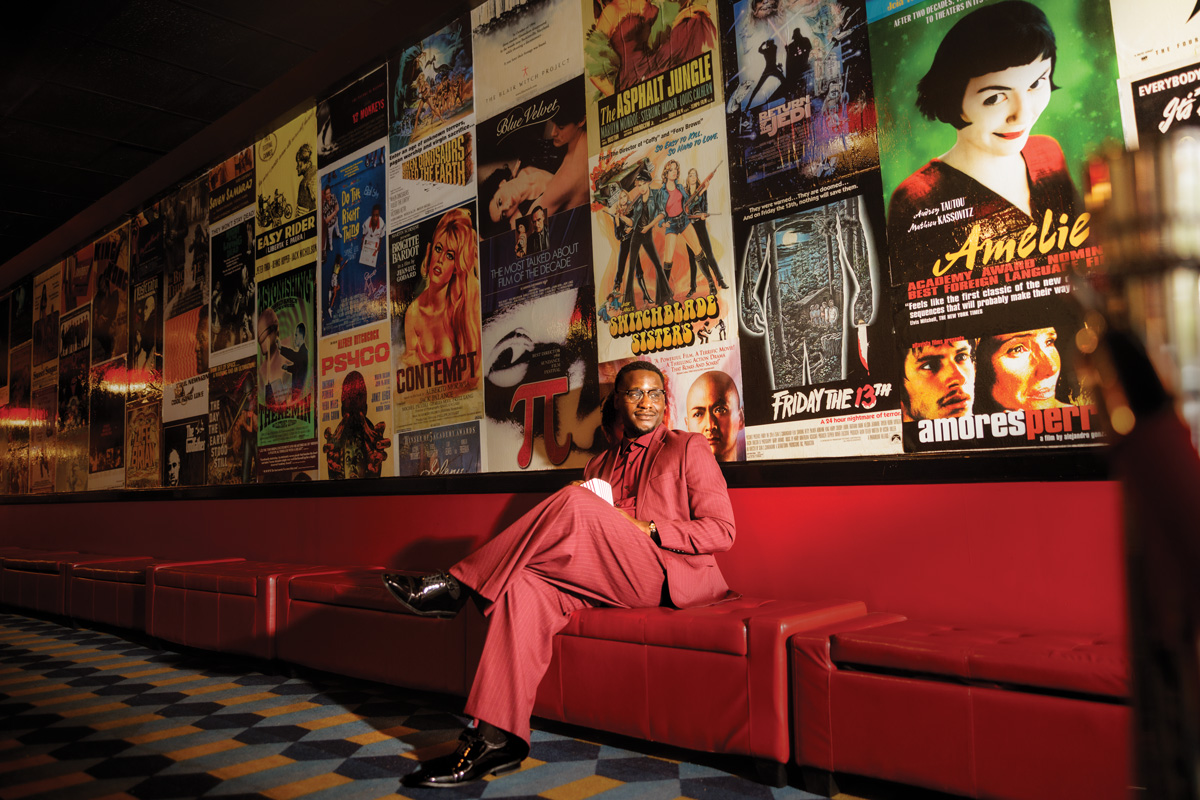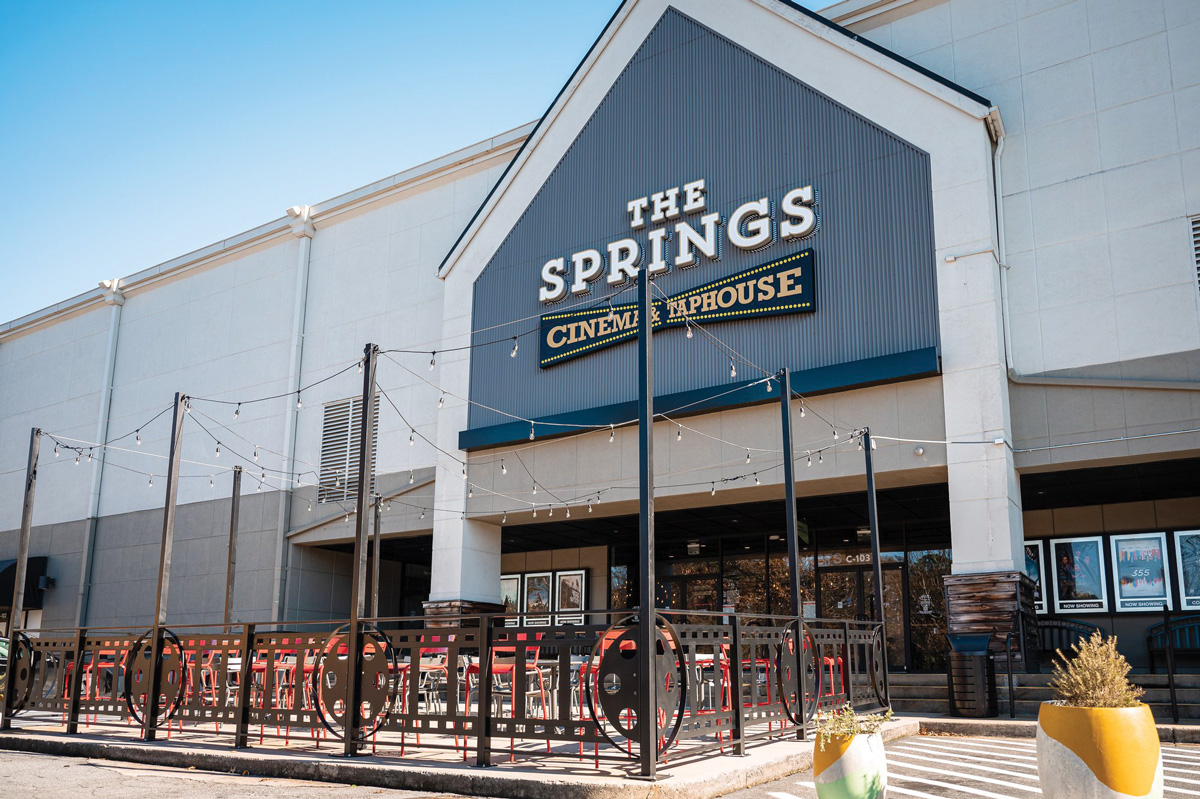
Photograph by Fernando Decillis
Atlanta filmmaker David Fortune vividly remembers his first time at the Plaza Theatre. In 2014, while a film student at Morehouse College, Fortune volunteered at the Atlanta Film Festival, curious to learn more about how the industry worked. After sneaking into a screening of Dear White People, he knew: This was the career for him.
“That was the first time I became a director,” he recalls. This year, the 49th Atlanta Film Festival kicked off with a screening at the Plaza of Color Book—written and directed by David Fortune.
Today, the fate of the silver screen is more imperiled than ever, but small cinemas like the Plaza seem to have found a formula for success. In fact, Atlanta’s independently owned theaters—which also include Tara Theatre, Starlight Drive-In, The Springs Cinema & Taphouse in Sandy Springs, and Aurora Cineplex in Roswell—are doing better than ever.
Even as large movie theater chains close across the metro area, these indies have survived—and even thrived—in the age of streaming by planting roots in the local film community. It’s a mutualistic relationship. When Christopher Escobar became executive director of the Atlanta Film Society in 2011, he forged a partnership with the Plaza that helped save the theater from closing. The society established the Plaza as a primary venue for its annual festival but also helped the theater grow its social media following, gain access to more independent films, and even upgrade to digital cinema projectors.

Photograph by Anthony Olivia Photography
In 2017, when then-owner Michael Furlinger put the Plaza up for sale, Escobar’s purchase of the theater just made sense. His first order of business was expanding from one screen to three to increase programming and boost ticket sales. In 2023, he rescued Tara Theatre—a midcentury-modern jewel box with a light-up facade—after Regal Cinemas had abruptly closed it the year prior, and brought it into the Atlanta Film Festival fold.
Brandt Gully found himself in a similar spot in 2017 when local movie theater mogul George Lefont—also a former owner of the Plaza and Tara—decided to sell his eight-screen Sandy Springs theater, Lefont Sandy Springs. Gully, who runs an entertainment investment firm, had long been an industry friend of Lefont’s, but he hadn’t planned to run a theater himself. After a close relative’s health scare, however, Gully found himself reevaluating what he wanted to do with his life. “A theater is a chance to be plugged into the community,” he says, “and work with local businesses, schools, charities, and churches.” After rechristening it The Springs Cinema & Taphouse, Gully set out to build the place into something new: not just a movie theater with plush reclining leather seats, but a true gathering spot.

Photograph by Fernando Decillis
Any theater can screen the latest big action flick, but what makes independents stand out is their willingness to take a risk and get creative with what they show. While the Plaza and its sister cinema Tara screen new releases, a major cornerstone for both theaters is screening repertory films—the industry term for titles past their original theatrical run. Even though Escobar’s theaters are small, this approach gives him an edge when it comes to scale. Commercial cineplexes like AMC Theatres or Regal typically boast as many as eight screens but show only about 125 films a year. Combined, the Plaza and Tara screen about 500 films a year on seven screens.
Programming manager Richard Martin designs the theater lineup, often in partnership with local businesses, organizations, and even dedicated cinephiles, all of which draw in unique audiences and help boost ticket sales across both theaters. Reel Friends, a narrative production company run by Rocco Shapiro, hosts screenings that are often accompanied by live bands. “Independent theaters get to curate series and challenge audiences in ways a mainline theater can’t,” Shapiro says. “You don’t need to go to film school to learn how movies are made; you can follow a monthlong program [of Plaza screenings] to learn about a genre or director.”
The benefits of these community partnerships flow both ways, with screening coproducers getting both brand awareness and a cut of ticket sales. When the Poncey-Highland DVD rental store Videodrome noticed its shop revenue slowing in 2018, it reached out to the Plaza to propose a cult classic screening series. “Plazadrome” kicked off with a store favorite, the 1977 Japanese horror flick House, and soon developed a cult following of its own. Today, the series has become a regular community event, expanding to art-house screenings at Tara and often featuring merch and Blu-ray DVD sales in the lobby and frequent guest Q&As with directors.
“Seeing an old movie on a giant screen and watching it with a crowd is a totally different experience than watching it by yourself,” says Matt Booth, the owner of Videodrome. “There are more cinephiles than ever thanks to Film Twitter and [film community app] Letterboxd. These screenings just fit into the culture.”

Photograph by Jarrod Cecil Photography
Although the pandemic sent the movie theater industry into a tailspin, independent cinemas were nimble enough to try survival strategies that corporate megaplexes couldn’t. In 2020, both the Springs and the Plaza converted their parking lots into drive-ins to screen old films, since so few new ones were coming out. This series helped put the Springs, a relatively new theater, on the map and establish it as a community hub.
These theaters’ efforts are paying off. In 2011, the Plaza made $180,000; last year, it earned more than $2 million for the second year in a row. That’s double its business from even prepandemic days, making it an outlier among indie cinemas, though much of that increase now goes to rising rent. Escobar says Tara is still playing catch-up: It’s collecting more now than when he bought it in 2023, but still hasn’t reached its pre-pandemic levels.
“The movie theater business is way less profitable than restaurants because there are far more strings attached,” Escobar notes. “Imagine if there were only five companies you could buy all your food from. That’s what studios are like.” Popcorn and other concessions, he adds, have helped to close the gap as Tara builds up its audiences.
Gully says the Springs is profitable, though he’s kept his investment job. He also put in a full restaurant and bar in the theater, adding another revenue stream to ticket sales. “In 2018, I had never even so much as remodeled a bathroom in my house,” he says. “But I decided to take on a massive construction project because I wanted people to walk in and see it’s a little different than your average theater.”

Photograph by Jarrod Cecil Photography
Gully says he spends 70 percent of his time thinking about marketing. When Barbie came out in 2023, he made a life-size toy box in his garage for patrons to pose in. “People came from all over the city because of that Barbie box,” he notes. “And if they are willing to pass other theaters on their way to you, it means you’re doing something right.” Activations like this are now a regular part of blockbuster releases at the Springs, and Gully brought on a full-time staffer to design programming, hoping to engage local customers with the kind of tailored events chain theaters can’t offer.
Regardless of such bells and whistles, independent cinemas’ biggest competition isn’t even giant commercial megaplexes; it’s people’s couches. Streaming means some films never make it to theaters, or they end up online a few weeks after theatrical runs. But as easy as it is to watch at home in pajamas, the trade-off for convenience is isolation. Indie theaters offer a collective experience in addition to entertainment.
“It’s not about just having great films and surround sound in a dark room, but seeing movies with a bunch of people and your undivided attention,” Escobar says. “Your living room will never replicate that.”
For Reel Friends’ Shapiro, indie theaters helped him rediscover his passion for the silver screen. “I worked at a corporate theater for many years and hated it, but indie theaters rewrote the narrative of my love for theaters,” he says. “Going to indie theaters with employees that really care and curate the films, and engaged audiences that love that film—[that] makes it a community.”
This article appears in our July 2025 issue.
Advertisement




